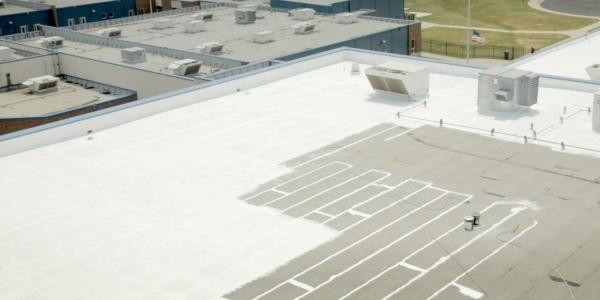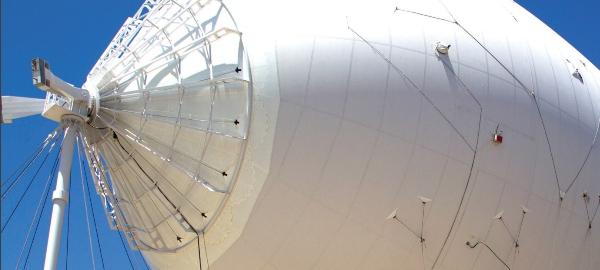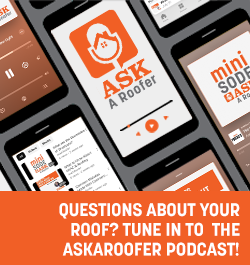How To Choose the Best Elastomeric Roof Coating

By Topps Products.
What is an Elastomeric Roof Coating?
An elastomeric roof coating is an elastic coating applied to a variety of roof types to protect and seal the underlying roofing material, help stop and prevent leaks, and limit future weathering. They are designed to move with the roof and be more forgiving rather than remain rigid, a quality that makes them especially durable. Some coatings are also designed to cool the building. The term elastomeric comes from the coating’s elastic quality to stretch and move.
Elastomeric roof coatings can be used on many industrial and commercial roof types such as metal roofs, concrete roofs, bitumen, modified bitumen or BUR roofs, EPDM roofs, or as a sealant over new SPF roofs.
When to Coat a Roof
The best value from a roof coating comes when you apply it at the first sign of aging. By making needed repairs early, installing a full protective barrier at the same time, you create your “stitch in time that saves nine.” Wait too long and it is likely to cost the owner more. Too often, it costs a new roof, at three or four times the expense of a roof coating, which could have been avoided by paying attention to early signals.
After reviewing all of the many elastomeric roof coatings on the market, how do you select the best quality and value roof coating for your customers' needs?
Understand the Roof Restoration Process
Understanding the entire roof restoration process will help you to choose which elastomeric roof coating best suits your customers' needs. Most every roof has conditions requiring more of a coating's particular physical properties than it does of the others. It pays to compare all the physical properties because it only takes a weakness of one to result in failure. Some roof conditions, such as rust or leaks at seams or flashings, may make it necessary to apply specialized products in addition to a coating. If you believe the roof may need more than just a coating, we suggest researching roof restoration options from Topps roof restoration systems here.
To learn more about the full roof restoration process, read our full guide and watch the video below:
Physical Properties to consider in Elastomeric Roof Coating Purchases
When determining the best elastomeric roof coating to use on the roof, there are many physical properties that need to be taken into consideration.
Every roof is different in terms of construction, location, weather, sunlight, etc. It is impossible to ever know which physical characteristic will prove most important to the durability of a particular roof system, so we highly recommend you compare every one of them when you are reviewing the available roof coating products. The best roof coatings should perform well for your customer on every count.
Here are the properties to evaluate:
- Elasticity/Elongation: Elasticity is the ability of a material to stretch. The ability to stretch and also recover means that a roof coating can move with the expansion and contraction of the roof as the temperature changes without cracking. Remember, only products which recover after being challenged are ready to take on the next needs. Bubblegum for example has tremendous elasticity. But because it has no recovery, stretching it only makes it thinner and ultimately a mess. The higher the elasticity, the more likely the product will endure your customers' needs and fluctuations in the roof structure. When you couple this with recovery you get a product which can keep on performing.
- Tensile Strength (new): Tensile strength measures the ability of the product to hold together and avoid breaking. Roof coating companies typically only report tensile strength when the product is new and in the lab. Spoiler: It always changes once outside exposure and aging begins.
- Tensile Strength (aged): The tensile strength of a roof coating can deteriorate rapidly over time with exposure to the weather. We highly recommend that you select a manufacturer that can provide written, third-party tensile strength measurements of their coatings when they are aged and have been exposed to the elements. It provides an added level of comparison. The aged measurements of the best roof coatings often beat those of competitors’ new product measurements. That signifies a serious difference in coating quality and value over time.
- Perm Factor: The perm factor is the coating’s resistance to moisture vapor passing through it. A lower number shows less moisture can pass through it.
- Moisture Gain by Weight: Moisture gain by weight measures the coating's ability to absorb water vs repel water and protect the roof beneath. You want a roof coating that repels water away from the roof, rather than absorbing it into the roofing material which can accelerate aging and deterioration of the roof itself.
- Peel Adhesion: Peel adhesion measures the ability of the coating system to remain adhered to the roof surface under adverse conditions. If the roof coating doesn’t stay firmly attached, then it can’t properly protect the roof.
- Tear Resistance: The tear resistance of a coating is, just as it sounds, the resistance to tearing which can happen due to foot traffic, from roof movement, or from other shifts in the environment.
- Reflectivity: Reflectivity measures how much solar heat is reflected away from the roof by the coating. A cool, reflective roof surface allows all building components to work more efficiently and reduces maintenance needs and premature roof failure caused by UV damage and thermal shock.
Comparing Elastomeric Roof Coating Performance
When choosing the right elastomeric coating option for a particular roof, there’s more to consider than just the coating’s properties. Some sealants perform better than others relative to industry standards. Comparing performance between brands can help you decide which option is best for your customers' needs.
The chart below shows how Topps Seal® compares in performance against other alternatives based upon the ASTM Miami-Dade standard on some of the key properties for an elastomeric roof coating.
Roof Coating Standards Provide a Necessary Point of Reference
ASTM MIAMI-DADE STANDARD
The American Society for Testing Materials (ASTM) supplies national standards for testing procedures of elastomeric roof coatings. This allows purchasers to have a reliable set of standards when evaluating the best elastomeric roof coating.
Miami-Dade County, Florida, assigns to roof coating products what they consider to be minimal requirements for use in this challenging environment. In order to be approved for lawful use in the county, a product must undergo testing by a government-approved third-party laboratory to ensure that it meets the county's minimum standards (as shown under 100% Acrylic in the chart above).
The ASTM includes testing standards for elasticity, tensile strength, perm factor, moisture gain by weight, peel adhesion, and tear resistance. They stress that ALL of these characteristics hold equal importance when evaluating a roof coating. Having good results on just one element is not enough to use for selection criteria.
Selecting the best roof coating can have serious long-term implications, so at Topps, we actually recommend that you take your questions a few steps further than simply the ASTM standards, and focus on the entire package and how it might affect the outcomes. You can risk everything by choosing instead to focus on only certain features while overlooking the rest.
Consider real physical properties over the manufacturer's claims. Only the former will provide you with maximum benefits. Make certain that the product you choose is the most desirable option for the range of conditions in your customers' climates. Selecting a coating that can withstand any climate will be of benefit. Climates often involve various extremes during different seasons, and the more versatile and durable the coating, the better off the roof will be.
Third-party independent testing, beyond standards used only for marketing purposes, can be invaluable.
Because Miami-Dade County Florida has what most consider to be the gold standard set of requirements for roof coating characteristics, where passage is required for legal use in those areas, it can be an excellent starting criteria. Miami-Dade has an incredibly complex set of potential weather conditions (think heat, high humidity, hurricanes, etc.) and thus, needs very high standards for performance in building materials. The cost difference for higher quality products, if there is one, will be negligible in the scheme of things.
In addition to having requirements for performance when new in the lab, Miami-Dade Country approved products also require roof coatings to be tested when they are aged. After a coating is aged, you can get a much better understanding of the rate at which it deteriorates and changes. This will tell you much more about its value than initial lab testing on a new product. Their reporting shows you how it compares.
Ask your vendor about the use of their products across various conditions, but also Miami-Dade standards. Are they approved for Miami-Dade county? Can they provide you with the results of tests conducted on their aged products after exposure to the weather? This information is critical to finding the very best roof coating product available. Avoid products having the weakest link in the chain among important physical properties.
ENERGY STAR® RECOGNITION
Last, but not least, the ability of the roof coating to provide a cool roof is incredibly important. UV rays and thermal shock can cause serious damage and deterioration to a roof. A white elastomeric roof coating, having proven solar effective properties, provides protection against heat and therefore can also help to dramatically reduce the energy required to cool the building. We recommend seeking out products that carry the ENERGY STAR® mark to ensure that the roof coating product you are applying is providing your customers with these important cooling benefits.
Again, this is one component among a number that can be valuable to your customer. So consider the entire package. If a white roof coating degrades quickly over time it loses the energy and cooling benefits it initially offered. Consider those instead who also use CRRC Cool Roof Rating Council® for third-party verification on cool roof retention over time if this is important to your customer. Here again, coatings which diminish more quickly in cooling qualities typically offer less value in the other important physical factors above. You don’t want it to be the weak link in your “value chain”. CRRC reports this.
Reviews
ELASTOMERIC ROOF COATING REVIEWS
Outside of some highly specialized venues, it can be difficult to find detailed reviews of elastomeric coating products. How do you decide which products hold up best on metal roofs? Or which sealants are right for your roof conditions?
One way to evaluate an elastomeric coating product is to review 3rd party independent reviews such as Cool Roof Rating Council®, MiamiDade County (approval carries verification), and Energy Star®. These give you facts.
Check to see that the manufacturer actually recommends their products for the specific roof type and be sure all products recommended for the project are included.
You may also benefit from reading about the experiences of others who have used particular products themselves. There are few better sources of product information than certified independent test results verifying the outcomes, together with customers who have used elastomeric roof coatings whose conditions are identical to your customers' situation.
Conclusion
Selecting an elastomeric roof coating is an important decision that can have a significant impact on the longevity of a roofing project and on the roof itself. Be sure when you select a product that you ask questions about all of the physical characteristics of the product and how it is rated by third parties like ASTM and CRRC.
Go in wise. Know that comparing literature reports of a product new and in the lab are good as a starting point. Be sure to dig deeper to ensure the that you select the best roof coating for all of your customers' needs. The coatings that perform better on more areas are more likely to meet your needs over time.
Have questions? Feel free to contact Topps for information on roof coating standards and how our products stack up.
Original article source: Topps






















Comments
Leave a Reply
Have an account? Login to leave a comment!
Sign In